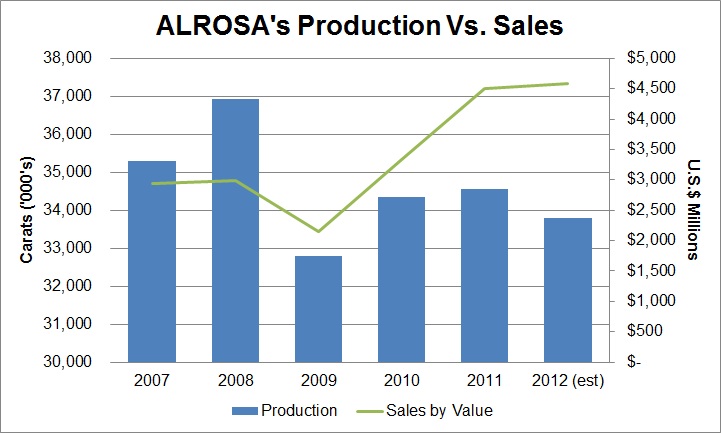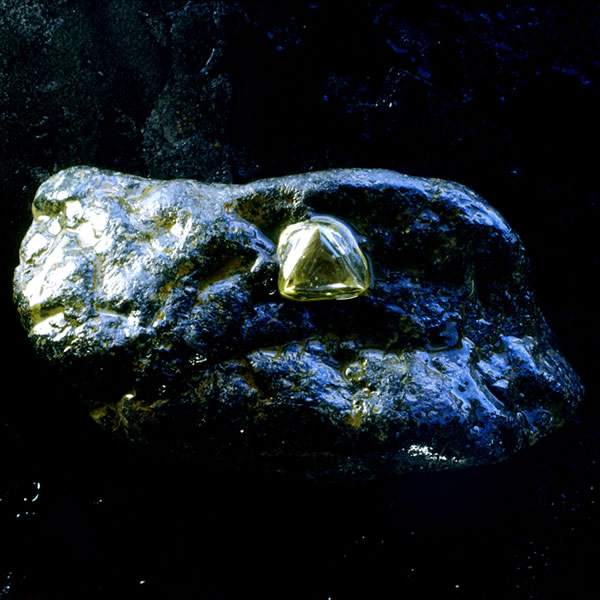ALROSA, the lesser known of the two diamond mining giants, is emerging from its own shadows and may exert greater influence on the industry in 2013. While it still has a ways to go, it has become more transparent about disclosing its resource base, building its client list and developing its marketing strategy.
Not so long ago, the company supplied the bulk of its production to De Beers, the other giant, for distribution, leading to monopoly charges against the two that ultimately led to the partnership’s termination. It also heavily relied on the Russian state-owned depository Gokhran as a sales backup when the going got tough.
Today, the company issues regular press releases and updates in Russian and English, posts all its financials online and, has a dedicated sales website. It is in the process of renewing its long-term supply deals with clients and penning new ones so that it has a stable and willing customer base. The company also appears to be selling its goods at fair price. And, there are encouraging talks to privatize the government’s majority share in the company, or at least parts of it.
In short, while still a somewhat unknown entity in the industry, ALROSA at the start of 2013 is a more open company that is leveraging its strong position in the market in a seemingly responsible way.
Naturally, there remain some concerns about the company.
The Gokhran factor
For one, ALROSA has increased its diamond inventory over the past year. In contrast to De Beers, which has curbed production during the current period of weak demand, ALROSA has maintained its production level and held back supply. ALROSA’s production during the first nine months of 2012 fell just 3 percent year on year to 25.4 million carats, while sales by volume slumped 21 percent to 22.3 million carats. Accordingly, the value of the company’s diamond inventory increased 32 percent to RUB 27.75 billion, or around $904 million.

Based on ALROSA reports and estimates (Source: Rapaport News).
Historically, a miner’s growing stockpile makes an inventory-sensitive diamond industry nervous. In ALROSA’s case, that concern is governed by its option to offload goods to Gokhran, an even darker horse for the market. Hopefully that option will dissolve as ALROSA’s long-term strategy evolves and as a potential privatization takes shape.
So far it hasn’t. For the first time since the 2008-09 crisis, ALROSA sold rough to Gokhran, selling about $90 million worth in the second quarter of 2012 with further sales of $140 million made since then. Andrey Polyakov, head of ALROSA’s public relations department, estimates that total sales to Gokhran will amount to $230 million in 2012. The company sold over $1 billion worth to Gokhran in the 2008-09 slump.
One state entity selling to another is problematic on many levels, not least that of pricing. Dinnur Galikhanov, an analyst with Aton Equity Research, told Rapaport News that these sales are made at prices determined by the Finance Ministry, which correlate with the actual market prices. It is certainly preferable that ALROSA hold the inventory than the government. One expects that the more goods are sold to contracted clients, the less ALROSA will require the Gokhran backup.
Partial privatization
But then, who knows what motivates Gokhran’s purchases or its sales for that matter. The Russian government’s inventory of rough, estimated at about $2 billion, remains an unknown shadow that could derail the market at any time. Galikhanov dismissed the possibility of such a significant volume of rough being dumped on the market as highly unlikely. Still, from a free diamond market point of view, the less involvement by any government the better, and one hopes that talks to reduce the state’s shares in ALROSA will transpire in 2013.
Furthermore, Galikhanov wrote in a recent note that a reduction in the state’s participation in ALROSA may in the long-term lead to the adoption of laws that could limit Gokhran’s ability to buy directly from ALROSA, unless the company wins the right to sell to the depository in an open tender process.
Currently, the Russian Federation owns 51 percent in ALROSA, the Republic of Yakutia holds 32 percent, and the Regions of Yakutia own 8 percent. Of the remaining 9 percent, 5 percent is held by legal entities and the other 4 percent by ALROSA personnel. Galikhanov noted there is little clarity on how the privatization will be carried out, and to what extent the government will offload its shares. An initial plan of a combined sale of 7 percent each from the Russian Federation’s portion and the Yakutia government’s share was reportedly met with resistance in Yakutia, as the republic stands to lose revenue royalties from the selloff.
Fair pricing
However, the pending privatization, if it occurs, should have little bearing on the way in which ALROSA operates in the short term. The company will continue to woo clients with the promise of consistent long-term supply and expects to sell 70 percent of its goods via its contracts going forward, with the remainder split between its auctions and spot transactions.
Significantly, ALROSA has the capacity and supply volume to compete with De Beers from a rough marketing perspective as well as production. Hopefully, it will diminish the widespread influence that De Beers supplier of choice (SoC) program and pricing play on the market. How both companies determine their price points is a significant unknown. But, as more companies procure more rough from ALROSA, the profitability with which its supply can be manufactured or dealt on the secondary market will take on increased importance.
Rough dealers and manufacturers are encouraged by the latest round of ALROSA sales. They reported that prices improved and that all the goods were taken. At previous sales, mainly in the third quarter, ALROSA clients “deferred” taking portions of their allocated supply. Anecdotal reports earlier in the year indicated expensive ALROSA rough relative to the market; the company reported that during the first nine months of 2012, the average price of its gem quality diamonds rose 4 percent year on year to $199 per carat.
Galikhanov notes that ALROSA is currently selling larger volume at lower prices, thereby reducing some inventory in the fourth quarter. He expects that the deferred goods will be taken by the clients in the spring, which he claims is generally a stronger period for the rough market. By then, one assumes that prices will have increased as well.
Long-term contracts
Such sales flexibility has resulted from ALROSA’s long-term supply deals, which the company started to pursue after the 2008 crisis, and many of which expire at the end of 2012. Polyakov said the new sales strategy has already proved effective. “ALROSA has the best sales figures in its history, and the rea son behind this is not only the growth of rough prices, but also a more responsible and better thought-out approach to marketing in general,” he explained.
As part of that strategy, in the past month, the company notched up some of the strongest players in the diamond pipeline. These include new clients Chow Tai Fook and Tiffany & Co., both major jewelry retailers that do in-house diamond manufacturing, and renewing its contract this week with Rosy Blue, a manufacturing powerhouse based in India. Other such agreements will undoubtedly follow in the coming months.
Polyakov notes that the deals exhibit the geographic diversification of ALROSA’s sales going forward and the financial strength of its client base — in other words, the potential stability of its future sales.
Hopefully, ALROSA’s client list won’t reflect the De Beers sightholder list too strongly when it’s complete, though it most likely will. Like De Beers, ALROSA has the resources, and arguably more so, to attract the strongest manufacturers well into the future.
Carats in the ground
The company recently revealed, for the first time, that it has a total reserve and resource of 967.5 million carats of diamonds, which Polyakov indicates will preserve the current level of production for the next 30 years. Production is expected to fall slightly below last year at 33.8 million carats in 2012.
The company has nine operating mines and ten alluvial deposits, excluding its stake in Angola’s Catoca mine, with at least four of its operations on track to produce more than 4 million carats for the year. Those include the Nyurbinskaya pipe, the International underground mine, the Jubilee pipe, and the Udachniy pipe. The Aikhal and Mir underground mines each produce around 2 million carats a year and its alluvial placers and tailings have combined production of around 4 million carats.
Polyakov reports that ALROSA’s two main developments constructing underground mines at Mir and Udachniy are expected to boost capacity at both operations in the coming years, while waste stripping at the Botuobinskaya diamond pipe is projected to yield commercial production in three years. In addition, the Severalmaz subsidiary is working to bring on the Lomonosovski mine into operation by the end of 2014.
All operations considered, ALROSA expects to increase production up to 38 million to 40 million carats a year by 2021 with its underground operations accounting for 60 percent of the total, up from 50 percent currently.
High hopes
It’s an enviable stash of diamonds, which ALROSA has been able to extract with relatively decent margins, a point that the company will undoubtedly stress to boost its investment potential. There’s no reason that investors shouldn’t take the bait. Hopefully, they’ll be given the chance. Hopefully, its long-term supply will be transparent and fair and provide effective marketing and pricing competition to De Beers. And hopefully it will break loose from its ties to Gokhran and manage its own inventory in a responsible manner.
There’s a lot of hope involved. But there’s also a lot at stake. And one feels there are many more unknowns, not to mention potential projects that may be further down the company’s to-do list. It might be viewing De Beers Forevermark activities with interest, for example, and a “Made in Russia” brand is hardly far-fetched. For now, the company remains relatively insular, despite its new-found transparency. As ALROSA continues to develop its operations and marketing strategy, and appears ready to emerge as a stronger influence on the diamond market, one suspects there’s a lot more to reveal.

